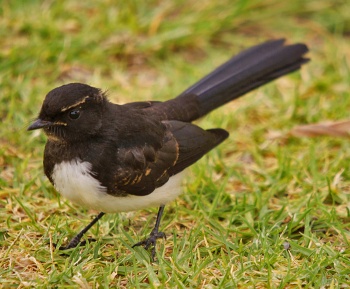- Rhipidura leucophrys
Identification
19-21.5cm (7½-8½ in)
- Black upperparts, throat and tail
- White underparts, supercillium and sub-moustachial whiskers
- Black bill and legs
- Dark brown iris
Sexes similar
Distribution
Australia, New Guinea, the Solomon Islands, the Bismarck Archipelago, and eastern Indonesia.
Taxonomy
It is unrelated to the true wagtails of the genus Motacilla.
Subspecies
Three subspecies are recognised[1]:
- R. l. picata:
- Northern Australia (Broome, Western Australia to Cape York Peninsula)
- R. l. leucophrys:
- Mainland Australia, except north
- R. l. melaleuca:
- Moluccas, New Guinea, Bismarck Archaepelago and Solomon Islands
Habitat
Most habitats, except dense forests - wetlands, urban lawns, parks, and gardens, golf courses.
Behaviour
Diet
The diet includes insects small fish, lizards, grass seeds and beetles.
Breeding
It builds a cup-like nest on a tree branch from grass stems, strips of bark, and other fibres, bound together with spider webs. The clutch consits of 2-4 creamy-white eggs with brownish markings which are incubated by the female for 14 days. The young fledge after a further 14 days.
References
- Clements, J. F., T. S. Schulenberg, M. J. Iliff, S. M. Billerman, T. A. Fredericks, B. L. Sullivan, and C. L. Wood. 2019. The eBird/Clements Checklist of Birds of the World: v2019. Downloaded from http://www.birds.cornell.edu/clementschecklist/download/
- Handbook of the Birds of the World Alive (retrieved November 2014)
- BF Member observations
Recommended Citation
- BirdForum Opus contributors. (2025) Willie-wagtail. In: BirdForum, the forum for wild birds and birding. Retrieved 10 May 2025 from https://www.birdforum.net/opus/Willie-wagtail
External Links
GSearch checked for 2020 platform.1






